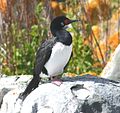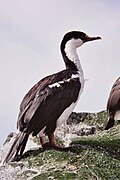| Blue-eyed shags | |
|---|---|
| South Georgia shag Phalacrocorax georgianus | |
| Scientific classification | |
| Kingdom: | Animalia |
| Phylum: | Chordata |
| Class: | Aves |
| Order: | Suliformes |
| Family: | Phalacrocoracidae |
| Genus: | Leucocarbo Bonaparte, 1856 |
| Type species | |
| Carbo bougainvillii (guanay cormorant) Lesson, 1837 | |
| Species | |
See text | |
| Synonyms | |
Phalacrocorax (in part) | |
Leucocarbo is a genus of birds in the cormorant and shag family Phalacrocoracidae. Several species within the genus are collectively known as blue-eyed shags. This is a group of closely related cormorant taxa. Many have a blue, purple or red ring around the eye (not a blue iris); other shared features are white underparts (at least in some individuals) and pink feet. [1]
They are found around the colder parts of the Southern Hemisphere, especially near southern South America, Antarctica, and New Zealand. Many are endemic to remote islands. Determining which types are species and which are subspecies of what larger species is problematic; various recent authorities have recognized from 8 to 14 species and have placed them in a variety of genera. The common names are even more confusing, "like myriad footprints criss-crossing in the snow and about as easy to disentangle." Only one common name is given for most species here. [1]















